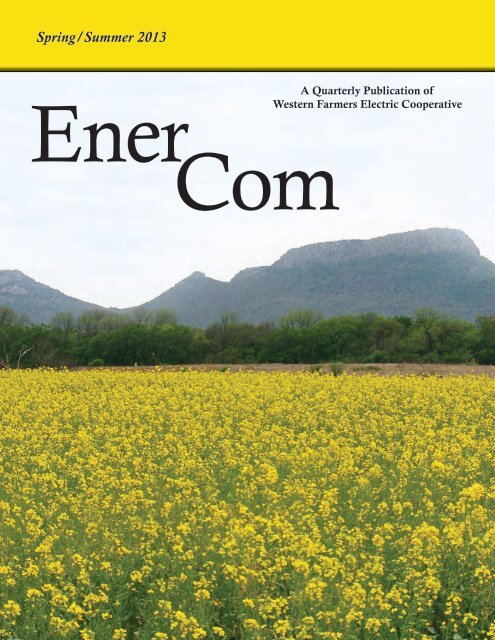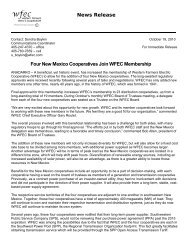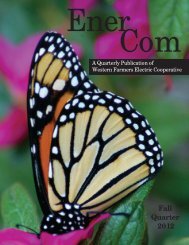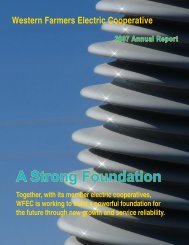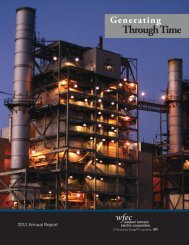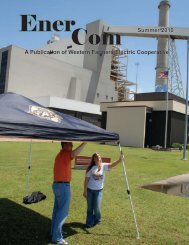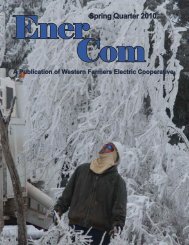Spring/Summer Quarter - Western Farmers Electric Cooperative
Spring/Summer Quarter - Western Farmers Electric Cooperative
Spring/Summer Quarter - Western Farmers Electric Cooperative
Create successful ePaper yourself
Turn your PDF publications into a flip-book with our unique Google optimized e-Paper software.
<strong>Spring</strong>/<strong>Summer</strong> 2013<br />
Ener Com<br />
A <strong>Quarter</strong>ly Publication of<br />
<strong>Western</strong> <strong>Farmers</strong> <strong>Electric</strong> <strong>Cooperative</strong><br />
1
Ener Com<br />
<strong>Spring</strong>/<strong>Summer</strong> <strong>Quarter</strong>, 2013 Volume XVI, No. 1<br />
<strong>Western</strong> <strong>Farmers</strong> <strong>Electric</strong> <strong>Cooperative</strong><br />
P. O. Box 429<br />
Anadarko, OK 73005<br />
(405) 247-3351<br />
www.wfec.com<br />
Cover:<br />
<strong>Spring</strong> has finally arrived<br />
in Oklahoma, with colorful<br />
wildflowers scattering along<br />
the roadways and countryside.<br />
Canola fields are also in full<br />
bloom throughout the area,<br />
including this one near the<br />
Wichita Mountains.<br />
(Photo by Sondra Boykin)<br />
Gary R. Roulet..................................................................CEO<br />
Brian Hobbs..................................VP, Legal & Corporate Svc.<br />
Mark Faulkenberry...........................Manager, Mktg. & Comm.<br />
Sondra Boykin, CCC.......................................................Editor<br />
Mark Daugherty, CCC..............................Writer, Photographer<br />
Maria Crowder.........................................Writer, Photographer<br />
Kansas<br />
Northwestern<br />
Alfalfa<br />
Kay<br />
Oklahoma<br />
Cimarron<br />
New Mexico<br />
<strong>Farmers</strong>’<br />
Kiwash<br />
Northfork<br />
Harmon<br />
Southwest<br />
Rural<br />
Caddo<br />
Cotton<br />
Oklahoma<br />
Rural<br />
East Central<br />
Oklahoma<br />
Canadian<br />
Valley<br />
Kiamichi<br />
Roosevelt<br />
County<br />
Texas<br />
Red River<br />
Valley Rural<br />
Southeastern<br />
Choctaw<br />
Lea<br />
County<br />
Central<br />
Valley<br />
2
Top Contest Winners Awarded<br />
Scholarship Dollars, Grants<br />
TThrough creativity and research, three Oklahoma high<br />
school students were awarded scholarship dollars as a<br />
part of the Go Go Geo Scholarship Video Challenge.<br />
These awards were presented during a luncheon banquet<br />
on April 22 in downtown Oklahoma City. The banquet<br />
culminated a two-day event, in which five contest<br />
finalists, along with their parents, met with sponsors,<br />
judges and other industry representatives.<br />
The Go Go Geo event was designed for the<br />
promotion of geothermal technology through the<br />
creative use of video and social media. The competition,<br />
consisting of a regional round and a state round, was<br />
sponsored by the Touchstone Energy® <strong>Cooperative</strong>s,<br />
along with geothermal manufacturers, ClimateMaster,<br />
Bosch and WaterFurnace, serving as co-sponsors.<br />
Ean Bonjour, a senior at Stillwater High School, was<br />
awarded a total of $10,000 in scholarship dollars by<br />
taking first place honors in this video challenge, which<br />
allowed eligible students the chance at showcasing<br />
their creativity, while competing for almost $60,000 in<br />
scholarship dollars and school grants. Entries consisted<br />
of unique videos, created<br />
by high school juniors<br />
and seniors from across<br />
Stories, Photos by<br />
Sondra Boykin<br />
Oklahoma and southeastern New Mexico, with over 50<br />
videos submitted.<br />
Bonjour’s award included $3,000 in scholarship<br />
dollars from the regional round and $7,000 for the<br />
top finish at the state level. For his first place finish,<br />
Stillwater High School, will also receive a total of<br />
$5,000 in educational grant money from the two<br />
rounds of competition.<br />
Second place went to Casee Cole, a junior at Pond<br />
Creek-Hunter Junior-Senior High School, which<br />
(Continued on Page 4)<br />
What were they thinking<br />
TThe latest video editing software has empowered people all over the world<br />
to tell their stories through movies, revealing both creativity and originality<br />
through these new techniques that are easily accessible for all ages.<br />
This creativity was certainly evident among those entering the Go Go<br />
Geo Scholarship Video Challenge, as students utilized musical talents,<br />
developed scripts, used artistry with drawings and graphics or took their<br />
imagination to the great outdoors.<br />
For five entrants, their skills and originality earned them a place in the final round of competition of the<br />
video challenge. So, just what led them to their unique ideas for explaining geothermal technology<br />
For Ean Bonjour, who took the first place honors in the competition that earned him $10,000 in<br />
scholarship dollars, it was a family-related idea that led him to his portrayal of the Wizard of Oz characters.<br />
“Our high school had just performed the Wizard of Oz, so my sister offered this as a suggestion,” he pointed<br />
out. He added that it also tied in with the Emerald City and some of the themes involving “going green”.<br />
(Continued on Page 6)<br />
3
Contest winners<br />
included a $3,000 scholarship from the regional<br />
contest, in addition to $3,500 for the state finish.<br />
Austin Branch, a senior at Norman High School North,<br />
received the third place scholarship award, consisting<br />
of a total of $5,000, including $3,000 for the regional<br />
finish and $2,000 for the state finals.<br />
Other finalists, listed with their school, included<br />
Kailey Kelley, Hinton High School; and Haley Madden,<br />
Portales (New Mexico) High School. These two each<br />
received $3,000 in scholarship dollars from the regional<br />
round of the contest and an additional $1,000 from the<br />
state finals.<br />
Video entries were judged on creativity, content,<br />
message delivery of geothermal themes and online<br />
voting, through social media, for each of the videos<br />
submitted. Plus in the final round, each of these factors<br />
was also included, in addition to an interview with the<br />
three judges. The videos of these five students are posted<br />
at http://www.gogogeochallenge.com.<br />
(Continued from Page 3)<br />
The judges for this competition included Betty<br />
Thompson, Miss Oklahoma 2012; Michael Ming,<br />
Oklahoma Secretary of Energy; and Stephen McKeever<br />
– Oklahoma Secretary of Science & Technology.<br />
Ming pointed out that he was “fabulously impressed<br />
by the students and their innovative ideas”. The judges<br />
also commented on how each student was so respectful,<br />
not only during the interviews, but during the informal<br />
conversation as well.<br />
“These students are very accomplished and it seems as<br />
if it is all self-driven,” commented Thompson.<br />
Each of the co-sponsors for the challenge noted that<br />
they too were impressed by the work of the students<br />
in creating their unique videos. “This event has built a<br />
new grapevine with fruit that will last for many years<br />
to come and then multiply,” commented Will Lange,<br />
director, utility market development and hyper sales,<br />
with WaterFurnace.<br />
For Dan Ellis, president of ClimateMaster, the Go Go<br />
State fnalists in the Go Go Geo Scholarship Video Challenge are pictured with contest judges<br />
following their interviews. Those shown are (from left) Austin Branch, Norman High School<br />
North; Michael Ming, Oklahoma Secretary of Energy; Kailey Kelley, Hinton High School; Ean<br />
Bonjour, Stillwater High School; Casee Cole, Pond Creek-Hunter Junior-Senior High School; Haley<br />
Madden, Portales (New Mexico) High School; Stephen McKeever, Oklahoma Secretary of Science &<br />
Technology; and Betty Thompson, Miss Oklahoma 2012.<br />
4
Geo Scholarship Video Challenge<br />
created a positive opportunity for<br />
manufacturers to work together.<br />
“I have watched this event come<br />
together. It was really a great<br />
idea,” Ellis pointed out.<br />
Mark Sullivan, national dealer<br />
development coordinator with<br />
Bosch, thought that the contest<br />
was great. “Any time we can<br />
get young people involved in<br />
our industry, it just helps the<br />
longevity of the industry itself.”<br />
Second and third place<br />
finishers in the regional round of<br />
competition, listed by placing in<br />
each region, included: Southeast<br />
Region - Hannah Faulkenberry,<br />
Community Christian School,<br />
and Jane Hughart, Checotah High School; Southwest<br />
Region - Ashton Lierle, Fort Cobb-Broxton High<br />
School, and Baylee Williams, Chickasha High School;<br />
Northwest Region - Joshua Tennial, Edmond Santa Fe<br />
High School, and Michael Mullins, Casady School;<br />
Northeast Region - Kaylee Byrd, Jenks High School,<br />
and Isaiah Colson, Ponca City High School; and New<br />
Representatives of the co-sponsoring geothermal manufacturers present for the<br />
awards presentation, included (from left) Will Lange, director, utility market<br />
development and hyper sales, with WaterFurnace; Dan Ellis, president of<br />
ClimateMaster; and Mark Sullivan, national dealer development coordinator<br />
with Bosch.<br />
WFEC Board President David Ray (center) and Mark Faulkenberry,<br />
manager of marketing and communications, present Ean Bonjour with<br />
a momento of his $10,000 scholarship after being named as the first<br />
place winner in the Go Go Geo Scholarship Video Challenge.<br />
Mexico Region - Delta Navarrete, Floyd High School,<br />
and Bree Stacey, Clovis High School.<br />
In the regional round of judging, first, second<br />
and third place winners in the contest’s five regions<br />
(divided by zip codes) were awarded scholarships of<br />
$3,000, $2,000 and $1,000, respectively, with the first<br />
place winner of each region advancing.<br />
“The Touchstone Energy<br />
<strong>Cooperative</strong>s have been excited about<br />
this project for high school juniors<br />
and seniors,” commented Mark<br />
Faulkenberry, WFEC’s manager,<br />
marketing and communication.<br />
“Some may not realize the magnitude<br />
of taking this important step that<br />
represents the innovative progression<br />
of cooperatives towards the heating<br />
and air conditioning of homes,” he<br />
added.<br />
“The advancement of geothermal<br />
technology is quickly making<br />
this option very viable for many<br />
homeowners, who may be interested<br />
in making a change,” he added.<br />
wfec<br />
5
Ideas for videos<br />
(Continued from Page 3)<br />
Bonjour, with the help of his mother, Rose,<br />
transformed their living room into a work area for<br />
making costumes, as well as shooting the video, which<br />
took several weekends. Bonjour<br />
did his own video editing and that<br />
too was time consuming to get the<br />
timing just right.<br />
As for his research, Bonjour<br />
went to Oklahoma State University<br />
and visited with Dr. Jim Bose,<br />
who has worked extensively with<br />
research agencies, manufacturers<br />
and contractors about the benefits<br />
of ground source heat pump<br />
systems. He noted that he learned a great deal about<br />
geothermal during his visit.<br />
Casee Cole, a junior at Pond Creek-Hunter Junior-<br />
Senior High School, utilized the changing seasons for<br />
her video presentation, based on geothermal technology<br />
being beneficial year-round.<br />
Cole used several landscape settings, including a<br />
wheat field near her home, as well as a park in Enid.<br />
Then, she also benefitted from a late season blizzard in<br />
her area. She explained that she did a lot of research for<br />
her project, which took about a week and a half to film.<br />
Cole received $6,500 in scholarship dollars for her<br />
second place finish in the video challenge.<br />
Austin Branch, a senior at Norman High School<br />
North, had a brainstorming session with several friends<br />
one evening as they were staying at his home. After<br />
ideas were tossed around, the suggestion to create<br />
unique lyrics to the theme song of “Fresh Prince of Bel-<br />
Air” was the final choice. “Obviously, I don’t rap,” he<br />
commented, but as Branch and his friends stayed up<br />
all night, rap lyrics about geothermal technology were<br />
created by morning.<br />
Branch said it took about two months to get all of<br />
the video shot and edited. Since several of his shots were<br />
outdoors, weather conditions played a role at times. Branch<br />
noted that he did not know much about ground source<br />
heat pumps in the beginning of the project, but learned a<br />
lot through researching the seven message themes.<br />
Branch earned a third place finish for this work,<br />
with $5,000 in scholarship dollars awarded.<br />
Haley Madden, a senior at Portales (New Mexico)<br />
High School, used pictures and<br />
words on a dry erase board to<br />
tell her story about geothermal<br />
technology. She noted that it<br />
took a long time for her to edit,<br />
as the drawings, words to describe<br />
the action in each scene, her own<br />
voice and a song, all had to be<br />
put together and synchronized.<br />
She too said she learned a<br />
lot about geothermal technology<br />
through her research and worked at creating her<br />
presentation in an understandable way to demonstrate<br />
the benefits of using geothermal.<br />
Madden earned $4,000 in scholarship dollars as a<br />
regional winner and state finalist.<br />
Kailey Kelley, a junior at Hinton High School,<br />
explained that she basically wrote an essay with the<br />
seven message themes included. She noted that this step<br />
involved a lot of research time in order to include the<br />
benefits and criteria of a geothermal system.<br />
She noted that it took several days to edit the<br />
video, with graphs and visuals being synchronized<br />
with the script that was being read on the video. Kelley<br />
also earned $4,000 in scholarship dollars as a regional<br />
winner and state finalist.<br />
For the contest, the seven message themes targeted<br />
the benefits of geothermal technology; as well as the<br />
costs involved; impacts on the utility company; and<br />
how technology and installation time has evolved with<br />
geothermal units.<br />
wfec<br />
The videos of these five students are posted at:<br />
http://www.gogogeochallenge.com.<br />
Also, interviews with the finalists can be seen at:<br />
www.wfec.com.<br />
6
New 2013-14 officers elected<br />
for WFEC Board of Trustees<br />
O<br />
Officers for the <strong>Western</strong> <strong>Farmers</strong> <strong>Electric</strong> <strong>Cooperative</strong> (WFEC) Board of Trustees were elected during an<br />
Organizational Meeting, hosted Wednesday, April 17 at the cooperative’s Anadarko headquarters. The Board’s<br />
Organizational Meeting followed the Annual Meeting of Members, in which 22 of the existing trustees were<br />
returned to the Board, with one new addition.<br />
These meetings were<br />
hosted after the regular<br />
monthly Board of Trustees<br />
meeting.<br />
David Ray (seated),<br />
who serves on the Board<br />
of Kiamichi <strong>Electric</strong><br />
<strong>Cooperative</strong> in Wilburton,<br />
was re-elected as WFEC<br />
Board President for the<br />
coming year. Other officers,<br />
all re-elected to their<br />
current positions, include<br />
(standing, from left) Gary<br />
Crain, who serves on the<br />
Board of Canadian Valley<br />
<strong>Electric</strong> <strong>Cooperative</strong><br />
in Seminole, assistant<br />
secretary-treasurer; Charles<br />
Hickey, a trustee from<br />
Northfork <strong>Electric</strong> <strong>Cooperative</strong> in Sayre, vice president; and Mike Lebeda, a trustee from Kay <strong>Electric</strong> <strong>Cooperative</strong><br />
in Blackwell, secretary-treasurer.<br />
Other Board members, listed with their respective cooperative, include: Colin Whitley, Alfalfa <strong>Electric</strong><br />
<strong>Cooperative</strong>; Bob Thomasson, Caddo <strong>Electric</strong> <strong>Cooperative</strong>; Charles Wagner, Central Valley <strong>Electric</strong> <strong>Cooperative</strong><br />
(NM); Bob Holley, Choctaw <strong>Electric</strong> <strong>Cooperative</strong>; Gene Peters, Cimarron <strong>Electric</strong> <strong>Cooperative</strong>; Charles Spencer,<br />
Cotton <strong>Electric</strong> <strong>Cooperative</strong>; Jerry Rempe, East Central Rural <strong>Electric</strong> <strong>Cooperative</strong>; Donnie Bidegain, <strong>Farmers</strong>’<br />
<strong>Electric</strong> <strong>Cooperative</strong> (NM); Bob Allen, Harmon <strong>Electric</strong> Association; Leslie Hinds, Kiwash <strong>Electric</strong> <strong>Cooperative</strong>;<br />
John Ingle, Lea County <strong>Electric</strong> <strong>Cooperative</strong> (NM); Ray O. Smith, Northwestern <strong>Electric</strong> <strong>Cooperative</strong>; Rusty<br />
Grissom, Oklahoma <strong>Electric</strong> <strong>Cooperative</strong>; King Martin, Red River Valley Rural <strong>Electric</strong> Association; Jerry Partin,<br />
Roosevelt County <strong>Electric</strong> <strong>Cooperative</strong> (NM); Gary Jones, Rural <strong>Electric</strong> <strong>Cooperative</strong>; Lloyd Owens, Southeastern<br />
<strong>Electric</strong> <strong>Cooperative</strong>; Fred Stowe, Southwest Rural <strong>Electric</strong> Association; and Heath Sirmons, Altus Air Force Base<br />
(non-voting member).<br />
wfec<br />
7
Keystone XL pipeline to benefit<br />
WFEC, Oklahoma cooperatives<br />
It has been described in many ways - from a<br />
critical infrastructure project that will have a<br />
positive impact on the United States to a negative<br />
environmental risk. The TransCanada Keystone XL<br />
pipeline, currently under construction in Oklahoma,<br />
is important for future energy security and for<br />
strengthening the American economy, sources have<br />
said. While opponents believe the pipeline will<br />
worsen climate change and negatively impact water<br />
resources and sensitive habitats.<br />
For <strong>Western</strong> <strong>Farmers</strong> <strong>Electric</strong> <strong>Cooperative</strong><br />
(WFEC) and two of its member cooperatives, it is a<br />
desirable electric load that is boosting the economy<br />
across their service territories. But, it certainly isn’t<br />
a project that has been without hurdles. WFEC staff<br />
has been dealing with this Keystone project since<br />
2008.<br />
The proposed 1,179-mile Keystone XL Pipeline<br />
Project consists of a 36-inch-diameter crude oil<br />
pipeline, beginning in northeastern Alberta, Canada,<br />
and extending south to Steele City, Neb. Along with<br />
transporting crude oil from Canada, the Keystone<br />
XL Pipeline will also support the significant growth<br />
of crude oil production in the United States from<br />
producers in the Bakken region of Montana and<br />
North Dakota.<br />
This pipeline will also allow Canadian and<br />
American oil producers more access to the large<br />
refining markets found in the American Midwest,<br />
according to sources. The third phase of the pipeline,<br />
known as the Keystone-Cushing Extension, will<br />
also deliver both Canadian and domestic oil over<br />
400 miles south to refineries on the Gulf Coast near<br />
Houston.<br />
The U.S. reportedly consumes 15 million barrels<br />
of oil each day, according to the Keystone XL project<br />
website. About 60 percent of that oil (eight to<br />
nine million barrels) must be imported from other<br />
8<br />
countries. Top suppliers<br />
of crude oil to the U.S.<br />
are Canada (29 percent),<br />
Saudi Arabia (14 percent),<br />
Venezuela (11 percent),<br />
Nigeria (10 percent) and<br />
Mexico (8 percent).<br />
Story by<br />
Sondra Boykin<br />
Photos by<br />
Scott Williams<br />
Despite growing domestic oil production, both<br />
the U.S. Energy Information Administration and the<br />
International Energy Agency have forecast that the<br />
U.S. will continue to import 3.5-to-7.5-million barrels<br />
per day into the year 2035, to meet American demand.<br />
<strong>Cooperative</strong>’s Role<br />
WFEC is building substations through which<br />
Canadian Valley <strong>Electric</strong> <strong>Cooperative</strong> (CVEC) and<br />
Southeastern <strong>Electric</strong> <strong>Cooperative</strong> (SEC) will provide<br />
electric service to the pipeline pumping stations<br />
within their respective service territories. There are<br />
five pumping stations that cross Oklahoma, and<br />
through negotiations, these two cooperatives are<br />
serving two of these five facilities. TransCanada<br />
information explains pumping stations are located<br />
about every 50 miles along the pipeline.<br />
Scott Williams, commercial and industrial<br />
marketing manager for WFEC, said plans call for<br />
the substation construction to be complete and<br />
functional by this summer. “We’ve been working on<br />
this project for a few years now, so it’s rewarding to<br />
see it coming together. And the benefits to CVEC,<br />
SEC and WFEC will be immediate. Members of both<br />
cooperatives will be affected in a positive way.”<br />
Williams goes on to point out the availability of<br />
electric service from WFEC and a commitment from<br />
these two cooperatives to provide reliable, affordable<br />
electric service are among the reasons TransCanada<br />
chose them as the project’s power supplier. The<br />
benefits of having the pipeline running through
this portion of the state will not only be felt by<br />
the cooperatives, as local communities are already<br />
enjoying the advantages. The construction jobs that<br />
TransCanada has brought to the region are infusing<br />
much-needed dollars into those communities.<br />
“This is a huge project,” said CVEC’s Manager of<br />
Operations Cordis Slaughter. “It’s been in discussion<br />
for two to three years, but actual construction<br />
began within the last year.” He goes on to explain<br />
the pipeline will run about 30 to 40 miles through<br />
CVEC’s service territory. “The pressure in the<br />
pipeline drops after traveling that 50 mile distance.”<br />
“The pumps in those stations will use electricity<br />
to restore the desired amount of pressure to the pipe<br />
so the oil can continue down the pipeline.”<br />
“What is attractive about this load is that it is<br />
constant. It isn’t like a residential load that peaks and<br />
drops throughout the day, and it’s not a seasonal load<br />
that comes online for a few weeks or months each<br />
year,” said Slaughter. “This is a constant load that is<br />
online 24/7. That allows for a more efficient use of<br />
CVEC’s investment.”<br />
“Pipeline employees are renting motel rooms,<br />
and RV parking spaces, they are eating in restaurants,<br />
buying fuel at gas stations, and shopping in local<br />
stores,” noted CVEC General Manager George Hand.<br />
“They are improving the economy as school systems<br />
and city and county governments are benefiting from<br />
the additional tax dollars. The economic boost to<br />
these areas from the jobs during construction and the<br />
ongoing operation is certainly significant.”<br />
Bob Weaver, manager of marketing and economic<br />
development at CVEC, indicated that a number of<br />
people are moving into the area, even to the extent<br />
of creating a shortage of homes. He pointed out<br />
that mobile home parks have been established to<br />
accommodate many of those being moved into the<br />
area. “Motel rooms are full, local restaurants are<br />
crowded and local businesses are busy,” Weaver<br />
noted. “It is really good to see new growth and the<br />
benefits of this construction have been exciting.”<br />
Jim Coleman, director of member services at<br />
SEC, headquartered in Durant, explained that this<br />
is a significant load for their cooperative. He also<br />
noted that this project has been a big boost for the<br />
economy as well throughout the construction phase.<br />
“Not only has the area benefitted through the<br />
addition of jobs, but positive impacts have been seen<br />
for the local economy as well,” Coleman commented.<br />
He added that restaurants, hotels, convenience stores<br />
and grocery stores are among those seeing an increase<br />
in business.<br />
Project Facts:<br />
(from Pipeline Project website)<br />
http://keystone-xl.com/<br />
• In May, 2012, TransCanada filed a new<br />
application for a Presidential Permit with the<br />
U.S. Department of State, a requirement for<br />
building any cross-border pipeline. TransCanada<br />
also chose to proceed with the southern portion<br />
of its Keystone expansion as a separate project,<br />
the Gulf Coast Pipeline Project.<br />
(Continued on Page 10)<br />
9
WFEC Station Specialist Billy Young (center) discusses plans at the Keystone XL Pipeline site with Larry<br />
Sibbald of TransCanada (right, back to camera), Rob LeForce, WFEC environmental specialist (far right)<br />
and the construction manager for the site (left). For WFEC and two of its member cooperatives, it is a<br />
desirable electric load that is boosting the economy across their service territories. But, it certainly isn’t a<br />
project that has been without hurdles. WFEC staff has been dealing with this Keystone project since 2008.<br />
Keystone pipeline<br />
(Continued from Page 9)<br />
• In January, 2013, Governor Dave Heineman<br />
approved TransCanada’s proposed route in<br />
Nebraska. The revised route will minimize<br />
disturbance of land, water resources and special<br />
areas in the state.<br />
• On March 1, 2013, the U.S. Department of State<br />
released a Draft Supplementary Environmental<br />
Impact Statement (Draft SEIS) on Keystone XL<br />
that reaffirmed “there would be no significant<br />
impacts to most resources along the proposed<br />
Project route.” With an anticipated decision on<br />
the Presidential Permit in 2013, the Keystone XL<br />
Pipeline has a projected in-service date of 2015.<br />
• The pipeline will have capacity to transport 830,000<br />
barrels of oil per day to Gulf Coast and Midwest<br />
refineries, reducing American dependence on oil<br />
from Venezuela and the Middle East by up to 40<br />
percent.<br />
• The $5.3-billion Keystone XL Pipeline Project is the<br />
largest infrastructure project currently under way in<br />
10<br />
the United States. Construction of the 1,179-mile<br />
pipeline will require some 9,000 skilled American<br />
workers.<br />
• In addition to construction jobs, an estimated 7,000<br />
U.S. jobs are being supported in manufacturing<br />
the steel pipe and the thousands of fittings, valves,<br />
pumps and control devices required for a major oil<br />
pipeline.<br />
• TransCanada has contracts with more than 50<br />
suppliers across the U.S., including companies<br />
in Texas, Missouri, Pennsylvania, Michigan,<br />
Oklahoma, South Carolina, Indiana, Georgia,<br />
Maryland, New York, Louisiana, Oklahoma,<br />
Minnesota, Ohio, Arkansas, Kansas, California and<br />
Pennsylvania.<br />
(Portions of this story were used with permission from the<br />
Canadian Valley Electralite, the cooperative's member<br />
newsletter.)<br />
wfec
Langford returned for second term<br />
with Touchstone Energy® Board<br />
Warren Langford, chief executive officer of Cotton<br />
<strong>Electric</strong> <strong>Cooperative</strong>, was recently elected for a second<br />
consecutive three-year term on the Touchstone Energy®<br />
<strong>Cooperative</strong> Board of Directors. <strong>Western</strong> <strong>Farmers</strong><br />
<strong>Electric</strong> <strong>Cooperative</strong> (WFEC) nominated Langford for<br />
this position.<br />
As CEO of Cotton <strong>Electric</strong>, and alternate board<br />
member of WFEC, Langford is responsible for many<br />
leadership roles that help in providing the dependable<br />
delivery of electric power at a price the membership<br />
can afford. With the importance of the membership<br />
in mind, under Langford’s leadership, Cotton <strong>Electric</strong>’s<br />
employees and Board of Trustees live the Touchstone<br />
Energy Brand and utilize its programs to influence<br />
member perception.<br />
Through his guidance, the cooperative has fully<br />
utilized the Touchstone Energy programs and services.<br />
He has also actively participated and hosted customers<br />
at the NET Conferences and has seen firsthand the<br />
value and impact that nationally coordinated efforts<br />
have on his large power customers at levels that would<br />
be impossible to achieve locally.<br />
Langford has experienced many changes in his 38-<br />
year career and knows that price and power quality<br />
is no longer a local issue. Recent events have made it<br />
imperative that rural<br />
electric cooperatives<br />
stay active and<br />
have a united<br />
voice concerning<br />
legislation and issues<br />
that affect how we do<br />
business. Langford<br />
believes that<br />
through coordinated<br />
advertising,<br />
marketing and communication activities, Touchstone<br />
Energy has brought a level of positive recognition that<br />
rural electric<br />
cooperatives<br />
have never seen<br />
before. And, he<br />
recognizes the<br />
need for the<br />
continuance of<br />
these programs in<br />
the future.<br />
During his<br />
career, Langford<br />
has served<br />
in many<br />
capacities of the<br />
cooperative’s<br />
operation,<br />
from meter and line work to being a supervisor and<br />
manager over varied departments. In his most recent<br />
position prior to becoming CEO, Langford served as<br />
vice president of finance and administrative services,<br />
as well as being responsible for the cooperative’s<br />
subsidiary, Cotton <strong>Electric</strong> Services. Langford was<br />
instrumental in making this unique subsidiary the<br />
success it is today.<br />
At the local level, Langford has served his<br />
community in the role of mayor, in addition to<br />
being active on several industrial foundation and<br />
economic development committees and the volunteer<br />
firefighters association. He is also a graduate<br />
of Leadership Oklahoma. Langford, and his wife,<br />
Roynell, have two grown children, and reside in<br />
Temple.<br />
The Touchstone Energy Board of Directors consists<br />
of 14 cooperative professionals from across the<br />
nation, with the brand representing a nationwide<br />
alliance made up of more than 740 local, consumerowned<br />
electric cooperatives in 46 states.<br />
wfec<br />
11
Reflections of<br />
2013 Winter<br />
Photos provided by:<br />
Austin Partida, Kay <strong>Electric</strong><br />
Jeff Hyatt, Cimarron <strong>Electric</strong><br />
Sondra Boykin, WFEC<br />
12
POWER Magazine award presented<br />
to LCEC Generation at Conference<br />
Among those on hand for POWER Magazine's 2012 Top Plant Award presentation, on behalf of Lea<br />
County <strong>Electric</strong> <strong>Cooperative</strong> Generation included (from left) the publisher of POWER magazine; Gary<br />
Hurse, LCEC manager; John Ingle, LCEC Board president; Joe Broadwater, plant manager; Will Palmer,<br />
LCEC Board member; Grant Grothen of Burns & McDonnell; Robert Caudle, LCEC Board member; and<br />
Chris Marks, Burns & McDonnell. (Courtesy Photo)<br />
Lea County <strong>Electric</strong> <strong>Cooperative</strong> (LCEC) Generation, LLC was presented with POWER Magazine’s 2012<br />
Top Plant Award during the 2013 <strong>Electric</strong> Power Conference hosted in mid-May in Chicago, Illinois.<br />
This award recognizes a plant that has entered into commercial service within the past one to two years<br />
and leads the industry in the successful deployment of advanced technology and efficiency with minimal<br />
environmental impact. LCEC was profiled in the Sept. 1, 2012 issue of POWER Magazine.<br />
LCEC Generation is a 47 Megawatt (MW) gas-fired generation plant that was completed in 2012. It<br />
consists of five Wärtsilä reciprocating engines with the ability to bring the plant to full capacity in five<br />
minutes. The plant is tied directly to a 27 MW wind farm owned by Exelon, which is located southeast<br />
of the plant. This is the first generation project in the United States to pair the Wärtsilä gensets with wind<br />
energy.<br />
Award finalists and winners were determined by POWER Magazine editors from nominations submitted<br />
by designers, constructors, operators, and suppliers of power plants.<br />
General Manager Gary L. Hurse and Lea County <strong>Electric</strong> <strong>Cooperative</strong>’s Board President John Ingle<br />
accepted the award on behalf of the LCEC Generation Plant. Several LCEC board members and others<br />
related to this project also attended the conference.<br />
Established in May 1949, LCEC is headquartered in Lovington, NM, with branch offices located in<br />
Tatum, NM and Plains, Texas.<br />
wfec<br />
13
WFEC, cooperative line crews<br />
take part in switch training event<br />
When you work with electricity, there is<br />
no margin for error. That’s why continuing<br />
education and training is so important.<br />
Recently, more than a dozen distribution<br />
cooperatives were represented at the annual<br />
switch training certification sponsored at<br />
the Anadarko headquarters of <strong>Western</strong><br />
<strong>Farmers</strong> <strong>Electric</strong> <strong>Cooperative</strong>. Technicians<br />
from WFEC’s Anadarko Transmission<br />
and Distribution (T&D) teams, as well as<br />
specific plant personnel from Mooreland and<br />
Anadarko, also participated in the two-day<br />
training event.<br />
Instructors were from among WFEC staff,<br />
with classes including both classroom and onsite<br />
training.<br />
Certification topics covered control area<br />
services, clearance, hot line orders and switching<br />
procedures. The training also involved Occupational<br />
Safety and Hazard Administration (OSHA) safety<br />
guidelines and proper substation personal protective<br />
equipment. A certification exam was administered<br />
following the field training conducted at the nearby<br />
Sequoyah Substation.<br />
WFEC presenters included Station Technician Supervisor<br />
Terry Lisenbery, who made program introductions to<br />
attendees. Lisenbery also presented a video that focused<br />
on safety both in and outside the workplace. OSHA rules<br />
and safety was taught by Safety and Security Coordinator<br />
Kooney Duncan. Personal protective equipment and<br />
substations instruction was presented by Journeyman<br />
Station Technician Danny Briscoe.<br />
The certification exam covering control area services,<br />
clearance, hot line orders and switching procedures was<br />
conducted by Chief Transmission Operator Carroll<br />
Reddick and Transmission Operators Michael Hall and<br />
Bill Cook. Journeyman Systems Technician Ray Gamble<br />
presented the section on switch station and relay.<br />
Line switches was presented by Lead Power Line<br />
14<br />
Journeyman Station Technician Mike Roberson (center) observes two<br />
line workers during recent switch training at WFEC. More than a<br />
dozen distribution cooperatives were represented at the annual switch<br />
training certification sponsored at the Anadarko headquarters.<br />
Technician Steve Miller and Journeyman Power<br />
Line Technician Glen Fogle. The subject of 351R<br />
and Beckwith 2001 Equipment was presented by<br />
Journeyman Station Technician Mike Roberson.<br />
A tour of WFEC's control area was given to the<br />
participants by a team that included Transmission<br />
Operators Quintin Rogers, Cory Green, Clay Carr<br />
and Cook. Reddick also assisted in guiding this tour.<br />
The Anadarko Plant was also visited by the group,<br />
with Relief Shift Supervisor Bobby Hendrix and Hall<br />
providing information.<br />
Participants were also able to see how regulators<br />
are tested in a demonstration by Journeyman Station<br />
Technician J.D. Lewis, Briscoe and Roberson.<br />
At the T&D building, attendees viewed a new<br />
transformer and 125-foot boom truck, which is utilized<br />
by WFEC line crews use. Field training was conducted<br />
at the Sequoyah Substation, located east of the WFEC<br />
facilities. Participants had the opportunity to experience<br />
hands-on training under the guidance of Briscoe,<br />
Roberson, Reddick and Gamble.<br />
wfec
Chief Transmission Operator Carroll Reddick (front) was<br />
among those conducting the classroom sessions for those<br />
attending the annual switch training.<br />
Photos by<br />
Mark Daugherty, Brittany Hicks & Glen Fogle<br />
Safety, both in and outside of the workplace, was<br />
taught by WFEC staff to those attending the two-day<br />
switch training. Substation training included handson<br />
activities with clearance, hot line orders<br />
and switching procedures.<br />
15


